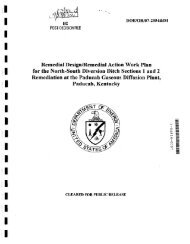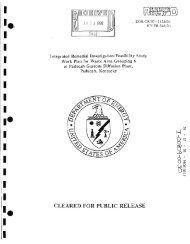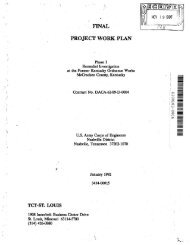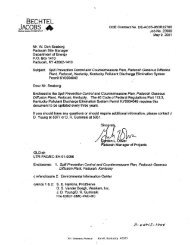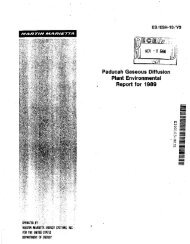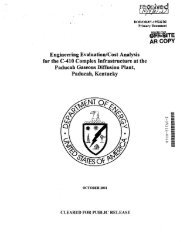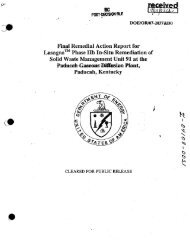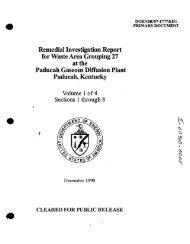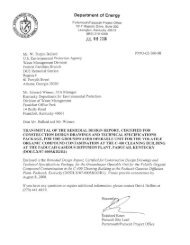1 - paducah environmental information center
1 - paducah environmental information center
1 - paducah environmental information center
Create successful ePaper yourself
Turn your PDF publications into a flip-book with our unique Google optimized e-Paper software.
1-1 -'-,-', --'-,' • SUrface<br />
Paducah Site<br />
for the TCE found at these locations. A<br />
detectable concentration of TCE was also seen at<br />
L 1. The data also shows acetone present at L 5.<br />
Chloride at the Bayou Creek downstream<br />
location was higher than at the upstream site.<br />
The highest concentrations of suspended solids<br />
and iron were found in the Ohio River. Uranium<br />
was also detected at low concentrations in all<br />
downstream creek locations.<br />
o<br />
3KM<br />
o 1 ~MW<br />
~ SOmpIJng<br />
A*II .<br />
Figure 8.1 Surface water monitoring locations at<br />
the Paducah Site.<br />
downstream of. plant effluents) and L 306<br />
(confluence of the Ohio and Mississippi Rivers<br />
at Cairo, Illinois) were added. Nqnroutine<br />
samples were· also collected ~t other locations. as<br />
needs dictated. The bimonthly samples were<br />
an8Iyzed for water quality parameters· such as<br />
VOCs, selected radionuclides, and dissolved<br />
meta1s~ The data can be used to compare<br />
upstreamandd~wnstream locations around the<br />
Paducah Site. .<br />
The results for the receiving creeks can be<br />
compared t~ the Paducah Site's KPDES permit<br />
standards which are based on warm water<br />
aquatic habitat criteria established by KDOW<br />
(401 KAR 5:031). All sample results for Bayou<br />
and Little Bayou creeks are within KPDES<br />
standards.<br />
Surface water samples are also taken on a<br />
quarterly basis at the C-746-S&T closed<br />
landfills. Samples are taken upstream of surface<br />
runoff from the . landfill, at the landfill, and<br />
downstream of the landfill. Data is reported<br />
quarterly to KDWM.. Appendix C provides the<br />
results of surface water monitoring. Figure 8.1<br />
shows monitoring locations.<br />
Additional ~urface water data can be found<br />
in Appendix C.<br />
Sediment<br />
,<br />
I'<br />
t<br />
,<br />
Surface Water Surveillance Results<br />
Table 8.1 shows average concentrations<br />
for parameters where upstream and downstream<br />
results differed noticeably. Only one sample of<br />
the eight samples collected had a detectable<br />
concentration of acetone. L 12 and L 241 had<br />
TCE concentrations of 4 mg/L and 34 mg/L,<br />
respectively. These stations are located in Little<br />
Bayou Creek downstream of L 10 (Figure 8.1).<br />
Recharge of the creek from the Northeast<br />
Groundwater Plume is believed to be responsible<br />
Sediment is an important constituent of the<br />
aquatic environment. If a pollutant is a<br />
suspended solid or is attached to suspended<br />
sediment, it can settle to the bottom (thus<br />
creating the need for sediment sampling), be<br />
taken up by certain organisms, or become<br />
attached to plant surfaces. Pollutants in solution<br />
can adsorb on suspended organic and inorganic<br />
solids or be assimilated by plants and animals.<br />
Suspended solids, dead biota, and excreta settle<br />
to the bottom and become part of the organic<br />
substrata that support the bottom-dwelling<br />
community of organisms. Sediments play a<br />
8-2<br />
Nonradiological Environmental Surveillance



